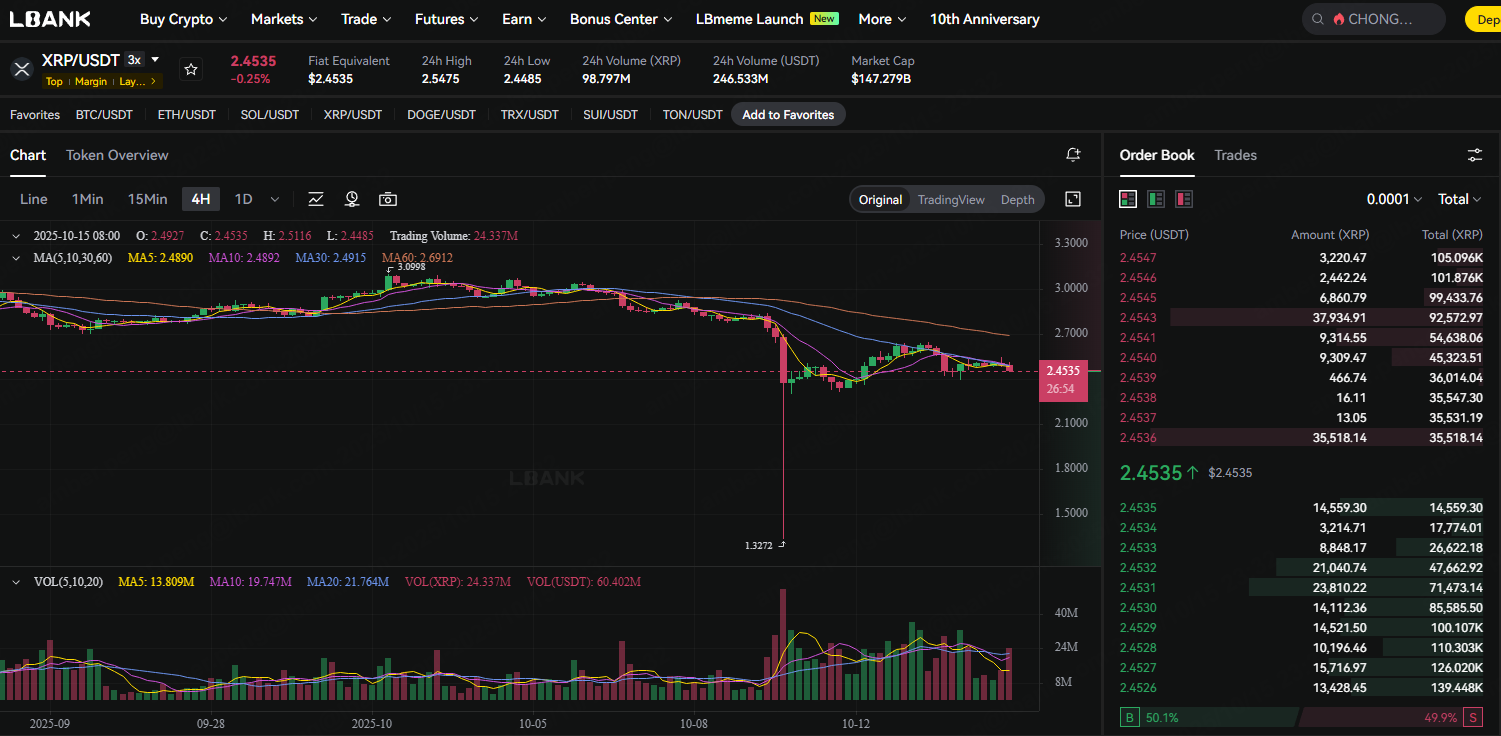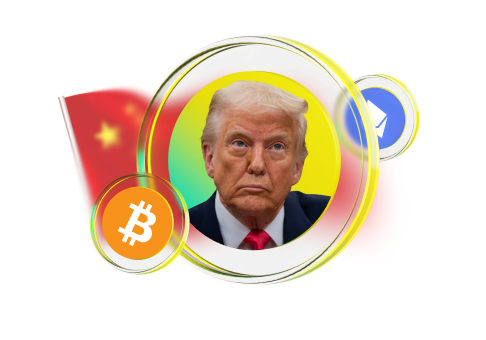How Trump's China Tariffs Triggered $19 Billion in Crypto Liquidations
The cryptocurrency market experienced one of its largest liquidation events in history when President Trump announced 100% tariffs on Chinese imports in October 2025. Bitcoin fell from $122,512 to $103,000 in hours. Over 1.6 million trading accounts got liquidated. The total damage reached $19 billion in just 24 hours.
This crash wasn't just another market correction. It revealed how government policy announcements can instantly destroy billions in crypto value. It also sparked controversy when a trader made $200 million by shorting Bitcoin minutes before Trump's announcement.
Review ETH Price on LBank
ETH() Price
The current price of
Why Tariffs Cause Crypto Market Crashes
Tariffs create what traders call "risk-off sentiment" in financial markets. When governments impose trade restrictions, investors worry about three main problems. First, tariffs increase inflation by making imported goods more expensive. Second, higher inflation prevents central banks from cutting interest rates. Third, trade wars slow down global economic growth.
Cryptocurrency sits at the extreme end of the risk spectrum. When investors get nervous, they sell risky assets first. They move money into safer investments like government bonds or cash. Bitcoin and other cryptocurrencies usually fall harder than stocks during these risk-off periods.
The October crash showed this pattern clearly. Crypto-linked stocks also crashed hard. Coinbase fell 16%. MicroStrategy dropped 8.7%. Galaxy Digital lost 5.4%. These companies all have significant exposure to cryptocurrency prices.
The Big Bitcoin Short: Perfect Timing or Insider Trading?
The most controversial part of the crash involves trader Garret Jin. He opened his short positions just minutes before Trump's announcement. His timing was so perfect that he made between $160 million and $200 million in hours.
Social media erupted with speculation about insider knowledge. Some rumors even linked the trade to Barron Trump, the president's son. Jin denied any connection to the Trump family. He claimed his trades were based on:
- Rising U.S.-China tensions
- Overbought conditions in risk assets
- Technical analysis signals
- Macro economic indicators
The legal situation remains unclear. Bitcoin is classified as a commodity, not a security. This means the Commodity Futures Trading Commission (CFTC) has jurisdiction, not the SEC. Proving insider trading would require evidence that Jin had access to nonpublic government information. Prosecutors would also need to show he traded based on that information.
Understanding the Scale of the Liquidations
| Asset | Price Before Crash | Lowest Price | Percentage Drop |
| Bitcoin | $122,512 | $103,000 | -16% |
| Ethereum | $4,390 | $3,447 | -21% |
| XRP | $2.8373 | $1.3272 | -53% |
| BNB | $1,274 | $877 | -31% |

XRP/USDT 4H price on LBank
The liquidation cascade worked like this. Traders use leverage to amplify their positions. When prices fall, exchanges automatically close positions that lack sufficient margin. These forced sales push prices lower. Lower prices trigger more liquidations. The cycle continues until leverage gets flushed from the system.
The $19 billion in liquidations represents one of the largest single-day events in crypto history. For comparison, the March 2020 COVID crash saw about $1 billion in liquidations. The May 2021 China mining ban caused $8 billion in liquidations.
The Broader Trade War Context
The tariff announcement didn't happen in isolation. It came after months of escalating tensions between the U.S. and China. The specific trigger was China's export controls on rare earth minerals. These materials are essential for:
- Defense equipment manufacturing
- Semiconductor production
- Electric vehicle batteries
- Renewable energy technology
China also stopped buying U.S. soybeans in May 2025. They were previously the top buyer, importing $12.8 billion worth in 2024. Trump called this an "Economically Hostile Act" and threatened a cooking oil embargo in response.
The trade war affects crypto markets because it impacts global liquidity and risk appetite. When major economies fight over trade, investors reduce exposure to speculative assets. Cryptocurrency, as the newest and most volatile asset class, suffers disproportionately.
What ETF Flows Tell Us About Institutional Interest
Despite the crash, institutional interest in crypto remained strong through 2025. The numbers show significant capital flowing into cryptocurrency ETFs before the October crash.
Ethereum ETF Performance (July 2025):
- Total inflows: $5 billion in July alone
- Cumulative inflows: $9.64 billion year-to-date
- Only one day of outflows: $1.8 million on July 2
Bitcoin ETF Performance (July 2025):
- Monthly inflows: $6 billion
- Cumulative inflows: $55 billion total
- Final July session: $114 million outflow
These flows provide important context. Institutional investors had been heavily buying crypto through regulated products. The October crash likely hurt these investors significantly. But their previous buying also provided some price support during the crash.
The Timeline of the October 2025 Crypto Crash
Tariff Shock Announcement
President Trump announced a 100% tariff on all Chinese imports starting November 1. Minutes earlier, a trader opened $700M in Bitcoin and Ethereum short positions on Hyperliquid, triggering panic as the news hit markets.
Market Meltdown Begins
Bitcoin plunged 16% within hours, Ethereum fell over 21%, and XRP crashed 53%. Forced liquidations swept through major exchanges as margin levels broke, wiping out billions in leveraged long positions.
Contagion and Fear Spread
Fear rippled through DeFi and CEX markets. Funding rates turned deeply negative, stablecoin depegs briefly appeared, and traders fled to cash and U.S. dollar–pegged assets amid the sell-off.
Partial Recovery Begins
Markets rebounded after Trump softened his tone. U.S. and Chinese officials confirmed trade talks would continue. APEC summit plans with Xi Jinping restored investor confidence, lifting BTC and ETH prices.
Price Scenarios for Bitcoin Through November 2025
Analysts identified three possible scenarios for Bitcoin prices heading into November:
Escalation Scenario ($90,000 - $105,000)
This happens if China retaliates with its own measures. The U.S. might then add more restrictions. Stock markets would fall 5-8%. The volatility index would spike higher. Bitcoin would test the $90,000 support level.
Base Case Scenario ($110,000 - $125,000)
This assumes both sides keep talking tough but don't implement new measures before November 1. Funding rates would normalize. Bitcoin would trade in a range between recent lows and highs.
De-escalation Scenario ($125,000 - $135,000)
This requires signals that tariffs might be delayed or reduced. Stock markets would stabilize. The dollar would weaken. Bitcoin could push toward new all-time highs above $135,000.
Review BTC Price on LBank
BTC() Price
The current price of
The Real Economic Impact Beyond Crypto
The tariff threats affect more than just financial markets. Research shows U.S. consumers already bear 55% of existing tariff costs. These tariffs have added 0.44% to inflation measures. If Trump implements the 100% tariffs, consumers could bear 70% of the costs. Inflation could increase by another 0.6%.
Higher inflation matters for crypto because it influences Federal Reserve policy. The Fed might keep interest rates higher to combat inflation. Higher rates reduce liquidity in financial markets. Less liquidity means less money flowing into risky assets like Bitcoin.
The Supreme Court will hear arguments in a tariff case on November 5. This could affect the president's ability to impose tariffs unilaterally. Market participants are watching this case closely.
Key Dates and Events to Watch
Crypto traders should mark these dates on their calendars:
- November 1, 2025: Deadline for 100% China tariffs to take effect
- November 5, 2025: Supreme Court tariff case arguments begin
- Late November 2025: Trump-Xi meeting at APEC summit in Seoul
Each of these events could trigger significant price movements. Traders should prepare for increased volatility around these dates. Risk management becomes essential when policy uncertainty is this high.
Lessons for Crypto Risk Management
The October crash teaches several important lessons about crypto investing. First, leverage amplifies both gains and losses. The traders who got liquidated were using too much leverage for the market conditions. Second, government policy can override technical analysis. Even perfect chart patterns fail when presidents make surprise announcements.
Third, correlation with traditional markets increases during crises. Bitcoin didn't act as a safe haven during the tariff scare. It fell along with other risk assets. Fourth, having cash reserves helps investors survive crashes. The traders who had dry powder could buy Bitcoin at $105,000 instead of getting liquidated at that price.
The crypto market will likely see more policy-driven volatility as governments grapple with trade and technology issues. Understanding how tariffs affect risk sentiment helps traders prepare for future shocks. The October 2025 crash won't be the last time government announcements cause billion-dollar liquidations in crypto markets.

